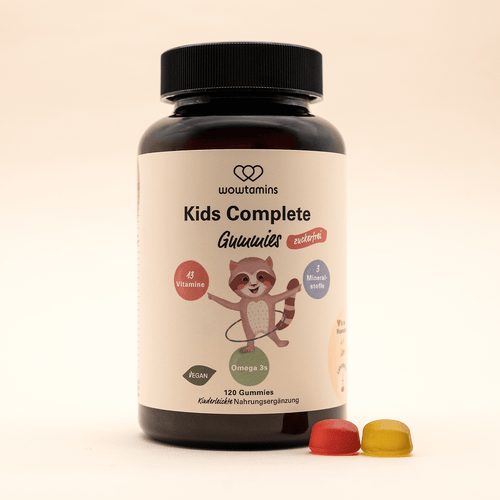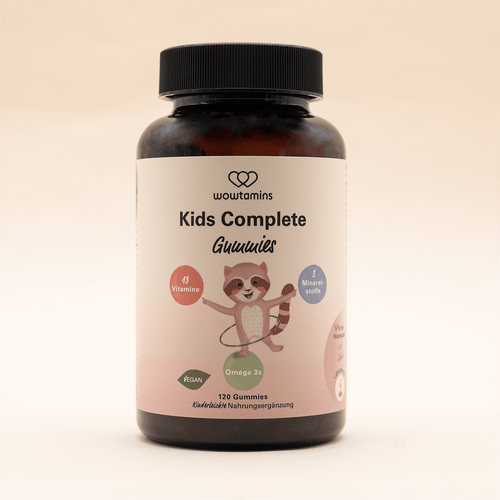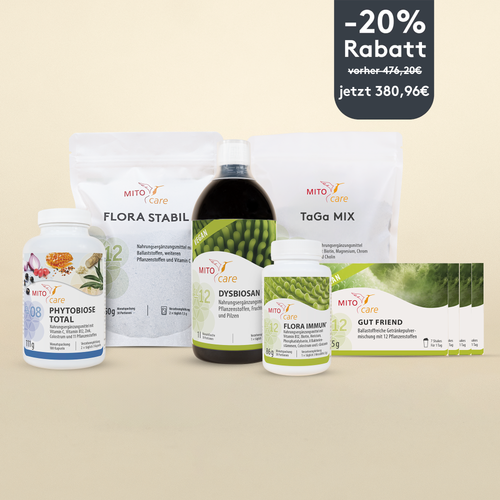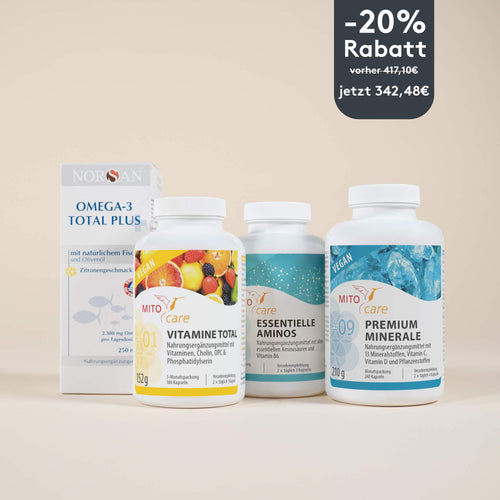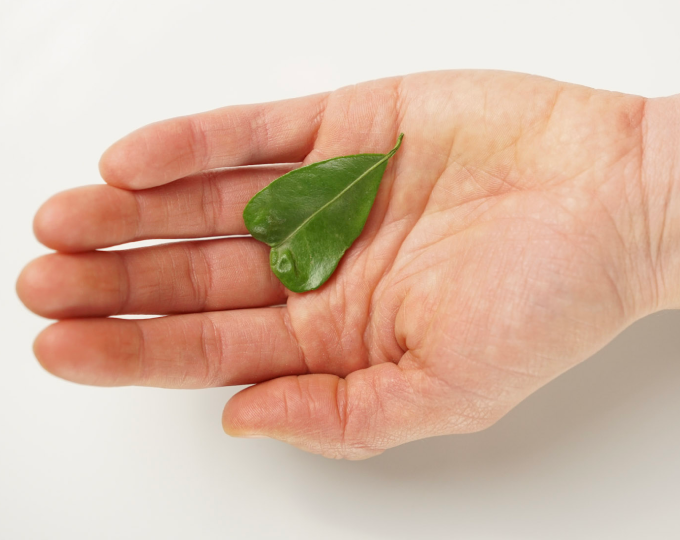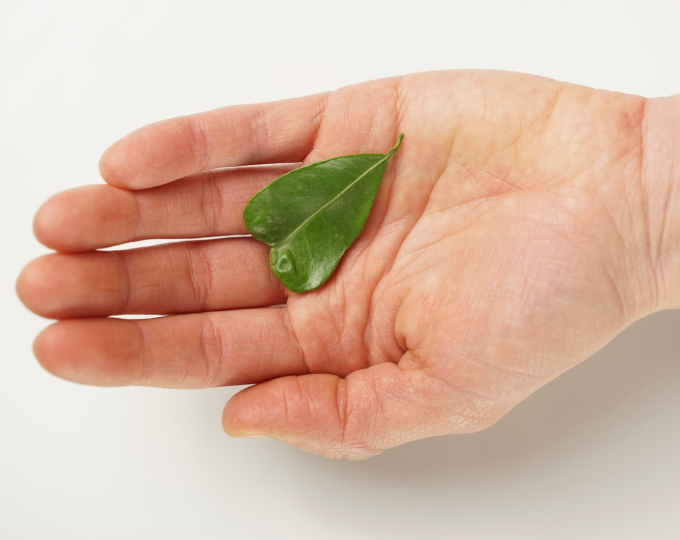Themen dieses Blogartikels:
What is vitamin A?
Retinol is also called vitamin A1 or axerophthol. Sometimes retinol is equated with vitamin A, which is not entirely correct.¹ Strictly speaking, the term "vitamin A" covers a whole group of compounds with vitamin A effects - with retinol being the main active form.² In addition to retinol, the oxidized form retinal, retinyl ester and 3-dehydroretinol are also included in the vitamin A group of substances. Good to know: Vitamin A is one of four fat-soluble vitamins. Fat-soluble means that retinol and co. need fat as a transport medium in order to be optimally absorbed by the body. You should therefore consume fat, for example in the form of vegetable oil, when you eat foods containing vitamin A.³
What are the functions of vitamin A?
Retinol is traditionally said to support visual function. In the form of the vitamin A aldehyde retinal, it is part of the visual process on the retina.⁴ But retinol can do even more: As retinoic acid, it can improve the utilization of iron, is involved in the differentiation of stem cells and thus in blood formation, and can support the immune system by forming white blood cells.⁵ Retinol is also important for the skin: the top layer of skin, the cornea, is formed with the help of this substance, among other things. Retinol therefore promotes the regeneration of the skin, which also makes the substance interesting for the cosmetics industry.⁶
What makes vitamin A unique?
Together with vitamin D, it can regulate the activity of over 500 genes as retinoic acid by attaching its receptor to binding sites on the DNA. Vitamin A is therefore a specific transcription factor for all kinds of genes.⁷ This is particularly relevant in connection with the immune system and cell differentiation: vitamin A compounds, for example, stimulate the formation of antibodies and activate certain immune cells, the T lymphocytes.⁸
How much vitamin A do you need per day?
Vitamin A and its precursors, regardless of the form, cannot be produced by the body itself. This essential micronutrient must therefore be supplied from outside via food. While retinol is only found in animal foods, the precursor of vitamin A, provitamin A carotenoids, is found in plants. However, the bioavailability of the various vitamin A compounds and the conversion rates of the provitamin A carotenoids differ greatly from one another. For this reason, the German Nutrition Society (DGE) specifies so-called retinol activity equivalents (RAE) in its vitamin A intake recommendation. The different properties of the various vitamin A compounds and provitamin A carotenoids were taken into account when calculating these:⁹
| Age | Retinol µg-Activity equivalent*/day male | Retinol µg-Activity equivalent*/day female |
| Infants | ||
| 0 to under 4 months | 500 | 500 |
| 4 to under 12 months | 400 | 400 |
| Children and young people | ||
| 1 to under 4 years | 300 | 300 |
| 4 to under 7 years | 350 | 350 |
| 7 to under 10 years | 450 | 450 |
| 10 to under 13 years | 600 | 600 |
| 13 to under 15 years | 800 | 700 |
| 15 to under 19 years | 950 | 800 |
| Pregnant women | ||
| 19 to under 25 years | 850 | 700 |
| 25 to under 51 years | 850 | 700 |
| 51 to under 65 years | 850 | 700 |
| 65 years and older | 800 | 700 |
| Pregnant women | 800 | |
| Breastfeeding | 1300 |
* Calculation basis: 1 μg retinol activity equivalent (RAE) = 1 μg retinol = 12 μg β-carotene = 24 μg other provitamin A carotenoids
When do you especially need vitamin A most?
If there is an iron deficiency or anemia induced by it, vitamin A together with iron can lead to an improvement in the condition more quickly than with iron intake alone.¹⁰ Pregnant and breastfeeding women have a slightly increased need and should therefore ensure an adequate supply through a balanced diet.¹¹
How does a vitamin A deficiency develop and how does it manifest itself?
A vitamin A deficiency can be the result of a liver disease that inhibits the storage of this micronutrient. But impaired fat absorption in the intestine can also hinder the absorption of fat-soluble vitamins such as retinol. This can be the case, for example, with chronic diarrhea, celiac disease, short bowel syndrome, Crohn's disease or cystic fibrosis. An early sign of a vitamin A deficiency is night blindness. In severe cases, this can later lead to complete blindness.¹² However, this mainly occurs in developing countries where a healthy, vitamin-rich diet is not guaranteed.¹³
What happens if you overdose on vitamin A?
Unlike water-soluble vitamins, fat-soluble vitamins such as retinol and other vitamin A compounds can be stored in the liver and in the body's fatty tissue. This means that while an excess of water-soluble vitamins is simply excreted, too much retinol and co. can be potentially harmful to health. However, a nutritional overdose is unlikely and in most cases is due to taking vitamin A-containing food supplements. Possible consequences can be skin changes or liver damage.¹⁴ Pregnant women and women who want to have children should generally avoid vitamin A-containing food supplements because a permanently increased intake can cause malformations in the child.¹⁵
Which foods contain particularly high levels of vitamin A?
Vitamin A is only found in animal products such as liver, eggs, fish and milk. The precursor β-carotene, on the other hand, is found in many fruits and vegetables, such as carrots, kale, pumpkin and mango. As the German Nutrition Society (DGE) reports, it is possible to cover daily requirements through an ovo-lacto-vegetarian diet. This is also possible with a vegan diet, provided there are no restrictions on fat digestion.¹⁶
This encyclopedia entry is based on carefully researched sources:
Bibliography & Sources
- chemie.de/lexikon/Retinol.html
- dge.de/wissenschaft/referenzwerte/vitamin-a/
- msdmanuals.com/de-de/heim/ern%C3%A4hrungsst%C3%B6rungen/vitamine/vitamine-im-%C3%BCberblick
- chemie.de/lexikon/Retinol.html
- lexikon.doccheck.com/de/Retinol
- bellevue.nzz.ch/beauty-wellness/kosmetik/wie-wirkt-retinol-und-was-muss-bei-der-anwendung-beachtet-werden-ld.1756875
- flexikon.doccheck.com/de/Retinol
- fet-ev.eu/vitamin-a/
- dge.de/wissenschaft/referenzwerte/vitamin-a/
- vitalstoff-lexikon.de/VitamineA-C-D-E-K/Vitamin-A/Interaktionen
- apotheken-umschau.de/gesund-bleiben/ernaehrung/vitamin-a-retinol-711989.html
- msdmanuals.com/de-de/heim/ern%C3%A4hrungsst%C3%B6rungen/vitamine/vitamin-a-mangel
- flexikon.doccheck.com/de/Vitamin-A-Mangel
- gesundheit.gv.at/leben/ernaehrung/vitamine-mineralstoffe/fettloesliche-vitamine/vitamin-a.html
- apotheken-umschau.de/gesund-bleiben/ernaehrung/vitamin-a-retinol-711989.html
- dge.de/gesunde-ernaehrung/faq/ausgewaehlte-fragen-und-antworten-zu-vitamin-a








